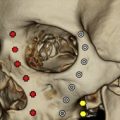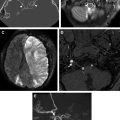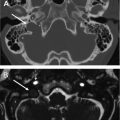Temporal bone trauma is commonly seen in patients with craniofacial injury and can be detected using multidetector computed tomography. A thorough understanding of the different types of temporal bone fracture patterns is needed to accurately describe the trajectory of injury as well as anticipated complications. Fractures should be described based on direction, segment of temporal bone involved, as well as involvement of the otic capsule. More importantly, the radiologist plays an integral role in identifying complications of temporal bone injury, which often have significant clinical implications.
It is important to identify associated complications related to temporal bone trauma that will guide management. Complications include injury to the tympanic membrane, ossicular chain, vestibulocochlear apparatus, facial nerve, tegmen, carotid canal, and venous system.
It is important to identify associated complications related to temporal bone trauma that will guide management. Complications include injury to the tympanic membrane, ossicular chain, vestibulocochlear apparatus, facial nerve, tegmen, carotid canal, and venous system.
The distal transverse and sigmoid sinuses travel through the posterior fossa within a groove along the medial margin of the mastoid portion of the temporal bone before exiting the skull base at the jugular foramen. These venous structures may also be injured when a fracture violates the sinodural plate or extends into the jugular foramen. It is important to review the soft tissue algorithm images of the posterior fossa as part of the temporal bone CT examination to assess for associated hyperdense venous sinus thrombosis, venous epidural hematoma, as well as associated cerebellar hemorrhage. Further evaluation with either CT venography or MR venography should be performed in those patients with fractures that involve the venous sinuses to assess the integrity of the venous system more comprehensively ( Fig. 16 ).
References
- 1. Dahiya R., Keller J.D., Litofsky N.S., et al: Temporal bone fractures: otic capsule sparing versus otic capsule violating clinical and radiographic considerations. J Trauma 1999; 47: pp. 1079-1083
- 2. Exadaktylos A.K., Sclabas G.M., Nuyens M., et al: The clinical correlation of temporal bone fractures and spiral computed tomographic scan: a prospective and consecutive study at a level I trauma center. J Trauma 2003; 55: pp. 704-706
- 3. Alvi A., and Bereliani A.T.: Trauma to the temporal bone: diagnosis and management of complications. J Craniomaxillofac Trauma 1996; 2: pp. 36-48
- 4. Brodie H.A., and Thompson T.C.: Management of complications from 820 temporal bone fractures. Am J Otolaryngol 1997; 18: pp. 188-197
- 5. Ghorayeb B.Y., and Yeakley J.W.: Temporal bone fractures: longitudinal or oblique? The case for oblique temporal bone fractures. Laryngoscope 1992; 102: pp. 129-134
- 6. Little S.C., and Kesser B.W.: Radiographic classification of temporal bone fractures: clinical predictability using a new system. Arch Otolaryngol Head Neck Surg 2006; 132: pp. 1300-1304
- 7. Nosan D.K., Benecke J.E., and Murr A.H.: Current perspective on temporal bone trauma. Otolaryngol Head Neck Surg 1997; 117: pp. 67-71
- 8. Ishman S.L., and Friedland D.R.: Temporal bone fractures: traditional classification and clinical relevance. Laryngoscope 2004; 114: pp. 1734-1741
- 9. Davidson H.C.: Imaging of the temporal bone. Neuroimaging Clin N Am 2004; 14: pp. 721-760
- 10. Gentry L.R.: Temporal bone trauma: current perspectives for diagnostic evaluation. Neuroimaging Clin N Am 1991; 1: pp. 319-340
- 11. Rafferty M.A., Mc Conn Walsh R., and Walsh M.A.: A comparison of temporal bone fracture classification systems. Clin Otolaryngol 2006; 31: pp. 287-291
- 12. Zayas J.O., Feliciano Y.Z., Hadley C.R., et al: Temporal bone trauma and the role of multidetector CT in the emergency department. Radiographics 2011; 31: pp. 1741-1755
- 13. Basson O.J., and van Lierop A.C.: Conductive hearing loss after head trauma: review of ossicular pathology, management and outcomes. J Laryngol Otol 2009; 123: pp. 177-181
- 14. Wennmo C., and Spandow O.: Fractures of the temporal bone–chain incongruencies. Am J Otolaryngol 1993; 14: pp. 38-42
- 15. Swartz J.D.: Temporal bone trauma. Semin Ultrasound CT MR 2001; 22: pp. 219-228
- 16. Meriot P., Veillon F., Garcia J.F., et al: CT appearances of ossicular injuries. Radiographics 1997; 17: pp. 1445-1454
- 17. Yetiser S., Hidir Y., and Gonul E.: Facial nerve problems and hearing loss in patients with temporal bone fractures: demographic data. J Trauma 2008; 65: pp. 1314-1320
- 18. Bin Z., Jingzhen H., Daocai W., et al: Traumatic ossicular chain separation: sliding-thin-slab maximum-intensity projections for diagnosis. J Comput Assist Tomogr 2008; 32: pp. 951-954
- 19. Lourenco M.T., Yeakley J.W., and Ghorayeb B.Y.: The “Y” sign of lateral dislocation of the incus. Am J Otolaryngol 1995; 16: pp. 387-392
- 20. Grant J.R., Arganbright J., and Friedland D.R.: Outcomes for conservative management of traumatic conductive hearing loss. Otol Neurotol 2008; 29: pp. 344-349
- 21. Fitzgerald D.C.: Head trauma: hearing loss and dizziness. J Trauma 1996; 40: pp. 488-496
- 22. Swartz J.D., and Mukherji S.K.: The inner ear and otodystrophies. In Swartz J.D., and Loevner L.A. (eds): Imaging of the temporal bone, 4th edition. New York: Thieme, 2009. pp. 298-411
- 23. Goodhill V.: Sudden deafness and round window rupture. Laryngoscope 1971; 81: pp. 1462-1474
- 24. Wang E.Y., Shatzkes D., and Swartz J.D.: Temporal bone trauma. In Swartz J.D., and Loevner L.A. (eds): Imaging of the temporal bone. New York: Thieme, 2009. pp. 412-443
- 25. Prosser J.D., Vender J.R., and Solares C.A.: Traumatic cerebrospinal fluid leaks. Otolaryngol Clin North Am 2011; 44: pp. 857-873
- 26. Oliaei S., Mahboubi H., and Djalilian H.R.: Transmastoid approach to temporal bone cerebrospinal fluid leaks. Am J Otolaryngol 2012; 33: pp. 556-561
- 27. Nash J.J., Friedland D.R., Boorsma K.J., et al: Management and outcomes of facial paralysis from intratemporal blunt trauma: a systematic review. Laryngoscope 2010; 120: pp. 1397-1404
- 28. Lambert P.R., and Brackmann D.E.: Facial paralysis in longitudinal temporal bone fractures: a review of 26 cases. Laryngoscope 1984; 94: pp. 1022-1026
- 29. Ulug T., and Arif Ulubil S.: Management of facial paralysis in temporal bone fractures: a prospective study analyzing 11 operated fractures. Am J Otolaryngol 2005; 26: pp. 230-238
- 30. Sartoretti-Schefer S., Scherler M., Wichmann W., et al: Contrast-enhanced MR of the facial nerve in patients with posttraumatic peripheral facial nerve palsy. AJNR Am J Neuroradiol 1997; 18: pp. 1115-1125
- 31. Patel A., and Groppo E.: Management of temporal bone trauma. Craniomaxillofac Trauma Reconstr 2010; 3: pp. 105-113
- 32. Resnick D.K., Subach B.R., and Marion D.W.: The significance of carotid canal involvement in basilar cranial fracture. Neurosurgery 1997; 40: pp. 1177-1181
Stay updated, free articles. Join our Telegram channel

Full access? Get Clinical Tree








